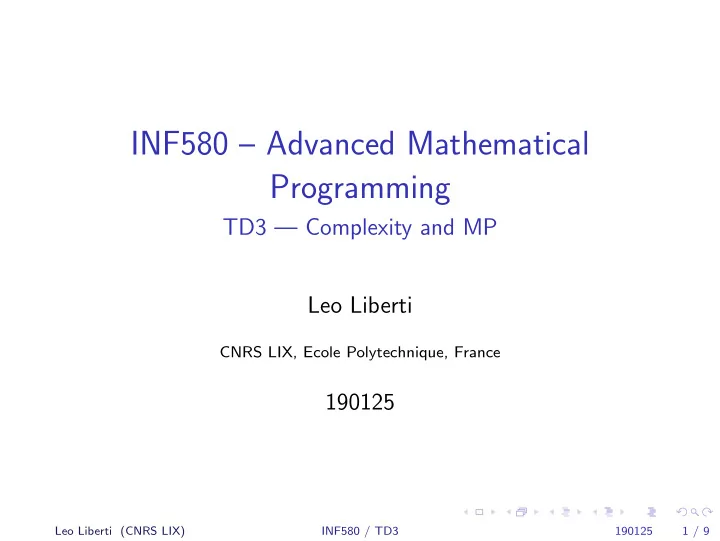

INF580 – Advanced Mathematical Programming TD3 — Complexity and MP Leo Liberti CNRS LIX, Ecole Polytechnique, France 190125 Leo Liberti (CNRS LIX) INF580 / TD3 190125 1 / 9
Simple AMPL codes Write AMPL code for the following problems: ◮ Max Clique ◮ subset-sum ◮ knapsack ◮ Hamiltonian Cycle and test them with the feasible and infeasible (whenever applicable) instances given in the course slides Leo Liberti (CNRS LIX) INF580 / TD3 190125 2 / 9
Random instance generators ◮ Coding up instances by hand is boring ◮ Let’s use AMPL to generate random instances! ◮ Each problem needs its own generator ◮ In general, for a problem called prob : 1. copy the index sets / parameters from prob.mod to prob-instgen.run 2. set sizes by hand (e.g. “ let n := 5; ”) 3. use AMPL imperative sublanguage to randomly fill set/param values 4. print to file Leo Liberti (CNRS LIX) INF580 / TD3 190125 3 / 9
Random instance generators Example: generating random graphs, Erd˝ os-Renyi model option randseed 0; # pseudornd gen starts from rnd seed ## start from sizes/index sets/params of original problem param n integer, > 0; set V := 1..n; set E within {V,V}; ## randomly generate missing index sets/params let n := 50; # initialize number of vertices param p := 0.5; # probability of creating edge let E := {}; # initialize the edge set to empty for {i in V, j in V : i < j} { # no loops or antiparallel arcs if Uniform(0,1) < p then { let E := E union {(i,j)}; # create the edge } } ## print out a .dat file (MIND YOU DON’T OVERWRITE OLD .dat FILES!) print "# file generated by clique-instgen.run" > rndcliq.dat; printf "param n := %d;\n", n >> rndcliq.dat; printf "set E :=" >> rndcliq.dat; for {(i,j) in E} { printf " (%d,%d)", i,j >> rndcliq.dat; } printf ";\n" >> rndcliq.dat; Leo Liberti (CNRS LIX) INF580 / TD3 190125 4 / 9
Random instance generators Example: uniformly distributed knapsack instances option randseed 0; # pseudornd gen starts from rnd seed param n integer, > 0; set N := 1..n; param c{N} integer; param w{N} integer; param K integer, >= 0; ## randomly generate missing index sets/params let n := 20; # initialize number of objects param cL := 1; param cU := 10; # bounds for object volume param wL := 1; param wU := 10; # bounds for object value let {i in N} c[i] := round(Uniform(cL,cU)); let {i in N} w[i] := round(Uniform(wL,wU)); let K := round((sum{i in N} c[i])/2); # generate capacity ## print out a .dat file (MIND YOU DON’T OVERWRITE OLD .dat FILES!) print "# file generated by knapsack-instgen.run" > rndknap.dat; printf "param n := %d;\n", n >> rndknap.dat; printf "param K := %d;\n", K >> rndknap.dat; printf "param : c w :=\n" >> rndknap.dat; for {i in N} { printf " %i %d %d\n", i, c[i], w[i] >> rndknap.dat; } printf ";\n" >> rndknap.dat; Leo Liberti (CNRS LIX) INF580 / TD3 190125 5 / 9
Random instance generators Example: normally distributed knapsack instances Change param cL := 1; param cU := 10; # bounds for object volume param wL := 1; param wU := 10; # bounds for object value let {i in N} c[i] := round(Uniform(cL,cU)); let {i in N} w[i] := round(Uniform(wL,wU)); to param cavg := 4.5; param cstdev := 1.9; # object volume param wavg := 5.8; param wstdev := 3.1; # object value let {i in N} c[i] := round(Normal(cavg,cstdev)); let {i in N} w[i] := round(Normal(wavg,wstdev)); Leo Liberti (CNRS LIX) INF580 / TD3 190125 6 / 9
Playing with instances ◮ How many vertices/edges does the largest Max Clique instance have, that CPLEX can solve in 30s on your laptop? ◮ Generate 9 random graphs, each with 160 vertices, and with edge generation probability p ∈ P = { 0 . 1 , 0 . 2 , . . . , 0 . 9 } ◮ Find max cliques on all these graphs ◮ use CPLEX as a solver ◮ use “ option cplex options "mipdisplay=2"; ” after “ option solver cplex; ” (shows CPLEX progress) ◮ record size ω ( G p ) of max clique of each graph G p and CPU time γ p for p ∈ P with bash: name random instances rndcliq-0.1.dat , . . . , then type (1 line): for i in 0.1 0.2 0.3 0.4 0.5 0.6 0.7 0.8 0.9 ; do cp rndcliq-$i.dat rndcliq.dat ; ampl clique.run ; done > clique.log 2>&1 & ◮ plot ω ( G p ) versus p and γ p versus p with bash: grep OUT: clique.log | cut -d ’:’ -f 2 Leo Liberti (CNRS LIX) INF580 / TD3 190125 7 / 9
The Motzkin-Straus formulation Write AMPL code to implement the Motzkin-Straus formulation for solving Max Clique ◮ make sure this formulation can read the same .dat files as those you already worked on ◮ test this formulation on the instance given in the course slides ◮ use a global optimization solver (e.g. baron ) and also a local optimization one (e.g. snopt ): what results do you obtain? ◮ can this formulation be solved using cplex ? ◮ what is the maximum instance size you can solve to global optimality with this formulation? What about local optimality? Leo Liberti (CNRS LIX) INF580 / TD3 190125 8 / 9
Structured formulation for sat ◮ Propose a numerical encoding for sat instances ◮ Based on this, write a structured MP formulation for sat ◮ Implement it in AMPL and test it using an appropriate solver Leo Liberti (CNRS LIX) INF580 / TD3 190125 9 / 9
Recommend
More recommend